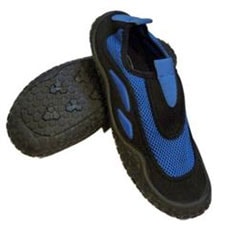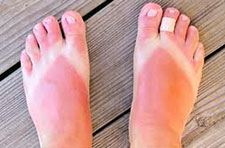Jimmy Buffett, the shepherd of summer vacationers, once famously blew out his flip flop, stepped on a pop top, and cut his heel. Fortunately, a frosty margarita was all it took to nurse the eternal beach bum back to full health, but those of us at University Foot and Ankle Institute would hate for a foot injury to interrupt your vacation fun.
Before you hit the beach this summer, check out these six hot tips for keeping your and your kids’ tootsies safe at the beach.
#1 Foot Cuts and Puncture Wounds
 Most beaches have rules against drinking from glass containers. Glass bottles easily shatter, and the debris can lurk in the sand, just waiting for a bare foot to cut. But glass isn’t the only dangerous shard out there: sea shells can cut your feet, too, and watch out for rusty nails and splinters on the boardwalk. A good pair of water shoes with sturdy bottoms should keep your soles intact.
Most beaches have rules against drinking from glass containers. Glass bottles easily shatter, and the debris can lurk in the sand, just waiting for a bare foot to cut. But glass isn’t the only dangerous shard out there: sea shells can cut your feet, too, and watch out for rusty nails and splinters on the boardwalk. A good pair of water shoes with sturdy bottoms should keep your soles intact.
If your foot gets cut, you should clean it immediately with soap or ointment from a first aid kit. Stay out of the water – oceans and lakes harbor bacteria that could cause an infection. A particularly nasty puncture wound should be treated by a foot and ankle specialist that same day.
#2 Burns on the Bottom of your Feet
Don’t get caught without shoes on the beach in the middle of the day: Sidewalks, blacktops, and even sand can heat up quickly when baking under the mid-day sun. Although flip flops aren’t the most protective footwear for most purposes, it’s best to keep a pair in your beach bag just in case you need to tip-toe your way across a hot parking lot.
#3 Jellyfish Stings
On some coasts, you might find jellyfish washed up on the shoreline. It’s best to avoid these blobs: their venom can still sting you even out of the water. If a tentacle gets stuck to your foot, carefully remove them without touching them directly with your fingers. The pain shouldn’t last longer than a day, but don’t scratch it – that will just aggravate the wound.
Alright, I know you’re wondering – is it true that peeing on a jellyfish sting will ease the pain? Science says no. Rinsing with freshwater, or watery urine, could make the stinging worse. On the other hand, you should rinse the area with vinegar or – handily enough – saltwater. Even better, you could make a paste of saltwater and baking soda to neutralize the burn. Science!
 #4 Sunburns and your Feet
#4 Sunburns and your Feet
It’s easy to forget about your feet when you’re slathering sunscreen onto your shoulders, back, and face, but don’t forget the tops and bottoms of your feet.
Skin cancer can affect any surface of your body.
#5 Arch and Heel Pain
Cushy sand makes for an awkward, uneven surface. Jogging, walking, throwing the Frisbee or playing beach volleyball can put strain on your feet and lead to pains in the heels and arches. Ankle sprains are also pretty common for beach-goers. Wear athletic shoes with arch support when playing sports on the beach – never rely on flip flops to protect your foot’s structure! If you do sustain an injury, bag some ice from the cooler, rest, and elevate your ankle. See a foot and ankle specialist within a few days if the pain doesn’t subside.
#6 Diabetes and your Feet
One symptom of diabetes is poor blood circulation and numbness in your feet. This is especially dangerous for diabetic beach-goers because they may not notice a cut or puncture wound right away. If it goes untreated, the risk for infection or ulcers increases. If you are diabetic, wear protective shoes and check your feet for cuts after walking.
If you would like more information, we encourage you to call us at (877) 989-9110 or visit us at www.footankleinstitute.com.
- Revolutionizing Extremity Imaging: UFAI’s Open MRI for the Foot and Ankle - October 21, 2023
- Youth Sports and Heel Pain: Should Kids Play with Pain? - April 4, 2023
- All About Foot Arch Pain and Foot Arch Cramps - March 15, 2021
Good information to read before I head to the beach on vacation. I do like to run on the beach. Beautiful place to run, but I do like to run barefoot. I will have try running there in good sneakers. Ankles injuries are the worst!
Thanks to this information I no longer have to wonder what cut my toe. Stupid seashells. Oh well ?